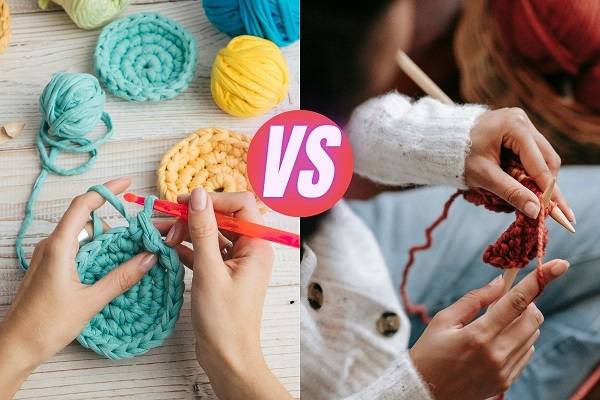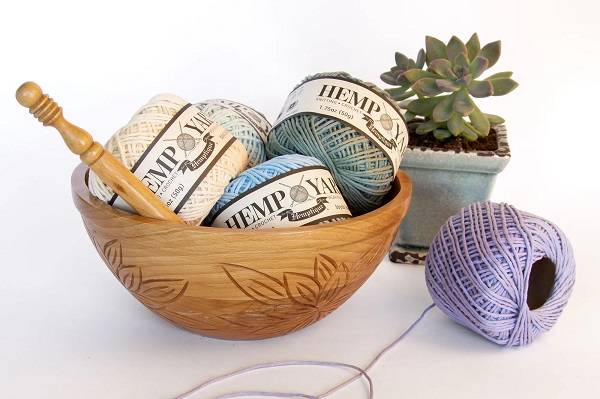Discover Which Type of Knitting Needles Are Best For Beginners
New to knitting? Discover our ultimate guide to needle types, sizes, and matching needles with yarn. Perfect for crafting your first sweater.

Innovation & Quality
Developing and supplying premium-quality, sustainably grown, consumer products
100% Natural
Organically Grown and Ethically Sourced
hemp and other natural fiber products
Shipping
We offer fast shipping
Your order out within 1-3 days
Wholesale
Visit our wholesale portal to register or login to your account
Needles and yarn are the two main tools you need to finish any knitting project. As a matter of fact, it is pretty astonishing what you can craft using only two sticks and a piece of thread. You can make anything from beginner-friendly projects such as scarves, beanies, and dish cloths to more advanced handmade knitwork like baby garments, sweaters, cardigans, and jackets.
The advice shared here should help you make knitting easier, simpler, and more enjoyable. Just because you’re a newbie, it doesn’t mean that you can’t craft beautiful knitwear. Here, you will find recommendations on what size, material, and type of needle to use to be able to craft marvelous items without much trouble. Use this guide as your quick reference guide to ensure you have the right tools for your newly discovered hobby.
Shop High-Quality Natural Blend Knitting Yarn For Enjoyable Crafting Moments
Welcome to Hemptique, a renowned manufacturer of eco-friendly art & craft supplies sourced from premium plant fibers, including hemp. For 30 years, crafters around the world have shown us loyalty and continue to purchase our products, suitable for all skill levels and every age. For anyone involved in knitting, we have designed the perfect yarn which will help you craft gorgeous knitwear that stands the test of time. Our 3-ply, heavy worsted hemp yarn is made of finest 65% cotton and 35% hemp and is suitable for knitting hats, shawls, scarves, blankets, Afghans, sweaters, cardigans, and many more. It’s durable, and gets softer after washing, making your garments gentler on the skin with time. It’s offered in 6 different colors and can be used not only for knitting, but also for crocheting, macrame, weaving, and other crafts. If you are interested in perks and benefits for distributors, apply for our wholesale program, or send a bulk order request for volume pricing benefits.
4 Types Of Knitting Needles
Your project should indicate what type of needles is required to complete it. Generally, knitting needles fall into one of the following categories:
Straight needles
These are the traditional needles with stopper on one end, and they come in many sizes and lengths. The knitting method is back and forth rows, and the size and length you choose will depend on project itself. In general, shorter lengths are ideal for knitting smaller items like baby clothes or dishcloths, while longer needles are used for crafting larger items such as blankets or throws because they can hold a large number of stitches at once.
Double pointed needles (DPNs)
Double pointed needles are straight with pointed tips on both ends and they also come in all sizes and lengths. Unlike standard straight needles, which shave a stopper that prevents stitches from slipping off, DPNs allow for stitches to be able to fall off both ends. With DPNs, you are constantly knitting in the circle, there’s no back and forth knitting as with straight needles. They are mostly used for making fabric in the round such as beanies, hats, and socks.
Interchangeable needles
Interchangeable needles are special knitting supplies, typically sold as a set of varying tips, cables, and a fastening tool. They allow you to have every size and length combination. A typical medium set includes tips (US 4 - US 11) and 2 or three different cable lengths. Using these components you will be able to create the preferred length of circular needles.

Circular knitting needles
Circular needles are made of 2 needle tips, roughly 5 inches long, connected with a flexible plastic cable. Beside selecting the tip size, you can also select tip’s length, and cables’ length. Tip length is mainly personal preference and most of them are between 2.75 and 5 inches. The shorter lengths are not as common since they are mostly used for crafting items with smaller circumference, such as baby socks.
When it comes to cable lengths, the most popular are 16, 24, and 32 inches. Shorter cables are appropriate for hats, while longer ones are mostly used for cardigans, jackets, and sweaters. Thanks to their flexibility, they can be used for creating both flat pieces and round fabrics. For this reason, it’s important to recognize what size you will need and which exact combination to buy.
Here are some guidelines to remember:
Most beginner projects require a medium size needle (US 6–8, 4 mm–5 mm)
- 16 inch cable length is great starting point for novice learners as it is suitable for various projects
- Always check the pattern to identify exact tools needed
Materials
After you’ve get familiarized with the basic needle types, it’s time to think of the materials they’re made of. They are offered in a range of different materials which affect their performance, functionality, and how they feel in hands.
Wood and bamboo
Bamboo and wood are light and comfortable to work with as they feel warm in hands. They grip fiber better than other materials which means that it is less probable to drop the stitches or have the needles slip out of your hands. This is why they are recommended for beginners. Plus, they are not expensive, so it’s easy to replace them when needed. Keep in mind that there are two small drawbacks - they are more likely to break after extensive use and they can splinter. Luckily, you can fix the splinters by using a nail file or sandpaper.
Metal (aluminum)
Aluminum is great for speed knitters who prefer yarn to easily slide of the needles. Bear in mind that some beginners might find this frustrating, so it’s best to try them out before you purchase a pair.
Plastic
Plastic is the cheapest material and a good option for learners. It’s not too slippery like metal, but still allows for the yarn to smoothly slide off. Usually, there’s a huge selection in craft stores, meaning they are readily available.
PRO TIPS: - If you prefer a more slippery needle, pick plastic and metal.
- Buy multiple sets and experiment with different materials until you find the one you like best.

What Needle Size to Use for Knitting?
After you determine preferred type and material, you need to find the correct size. In fact, one of the most commonly asked questions by beginners is what needle size to use.
The size refers to the diameter of the needle which affects the gauge. The gauge determines how big the loops will be. Consequently, it impacts the density and drape of the item you’re making. As with crochet hooks, knitting needles come in various sizes. Smaller sizes are typically used with lightweight threads, while larger sizes are used with bulkier yarn. If you are a beginner, choose mid-size needles such as US 6 - 10 (and worsted-weight yarn).
| US sizes | Metric (mm) | UK size |
|---|---|---|
| 5/0 | 1 mm | 19 |
| 4/0 | 1.25 mm | 18 |
| 000 | 1.5 mm | 17 |
| 00 | 1.75 mm | 15 |
| 0 | 2.0 mm | 14 |
| 1 | 2.25 mm | 13 |
| 2 | 2.75 mm | 12 |
| 3 | 3.25 mm | 10 |
| 4 | 3.5 mm | / |
| 5 | 3.75 mm | 9 |
| 6 | 4.0 mm | 8 |
| 7 | 4.5 mm | 7 |
| 8 | 5.0 mm | 6 |
| 9 | 5.5 mm | 5 |
| 10 | 6.0 mm | 4 |
| 10½ | 6.5 mm | 3 |
| 11 | 8.0 mm | 0 |
| 13 | 9.0 mm | 00 |
| 14 | 9.5 mm | - |
| 15 | 10 mm | 000 |
| 17 | 12 mm | - |
| 19 | 16 mm | - |
| 35 | 19 mm | - |
| 50 | 25 mm | - |
How To Match Needle Size To Yarn
Luckily for you, most yarns contain important information on their label, including suggested needle size. The size is usually represented by a symbol that resembles a pair of needles, accompanied by a number that indicates the size, commonly in US sizing. Certain manufacturers have gauge and sizing information represented by a square. Inside the square, you will see recommendations on needle size (or crochet hook size) to use with that particular yarn. For example, with this heavy worsted hemp yarn it is best to use US size 8 needles (5mm, 6 UK).
| Yarn weight & category | Recommended needle US size | Metric size | Projects |
|---|---|---|---|
| 0 – Lace Fingering, 10 count, crochet thread | 000 - 1 | 1.5 mm – 2.25 mm | Baby garments, socks, lace |
| 1 – Super fine Sock, Fingering, Baby | 1 – 3 | 2.25 mm – 3.25 mm | Baby garments, socks, lace |
| 2 – Fine Sport, Baby | 3 – 5 | 3.25 mm – 3.75 mm | Baby garments, socks, lace |
| 3 – Light DK, Light Worsted | 5 – 7 | 3.75 mm – 4.5 mm | Tank tops, sweaters, cardigans, Afghans |
| 4 – Medium Worsted, Afghan, Aran | 7 – 9 | 4.5 mm – 5.5 mm | Sweaters, jackets, accessories |
| 5 – Bulky Chunky, Craft, Rug | 9 – 11 | 5.5 mm – 8 mm | Afghans, hats, scarves, blankets |
| 6 – Super Bulky Bulky, Roving | 11 – 17 | 8 mm – 12.75 mm | Sweaters, shawls, hats, winter garments & accessories |
| 7 – Jumbo Jumbo, Roving | 17+ | 12.75+ mm | Rugs, throws, blankets, home décor, sweaters, Afghans |
NOTES:
- If the label doesn't state a size, it is best to use online resources such as manufacturer’s website, crafters’ communities, and other databases.
In case the yarn does not have a label at all, compare it to other yarns of similar thickness, or simply experiment with different size until you find what you’re looking for.
Does Color Matter?
If you are wondering how important needle color is, the truth is that color should also be considered as it can make your learning experience easier and faster. Here’s how. When you have a good color contrast between the yarn and needles, it will be easier for you to see and count each stitch. Ultimately, this may speed up your knitting and make you more confident in acquiring your skills. You should try to create a good contrast between the yarn and the needles, and avoid using the same color for both. For instance, if the yarn is black, choose lighter colored needles.
Crochet Needles Vs Knitting Needles
For crocheting, you are using only one needle, which is called a crochet hook. It’s a type of hooked needle that is used to create loops by pulling the yarn through. For knitting, you are using a pair of needles to create fabric by transferring loops between the two.
Apart from different techniques, it's not uncommon to get entangled with phraseology of knitting and crocheting crafts, especially because there are several different numbering systems.
Most of the world and the UK use metric system and millimeters to refer to knitting needle sizes, while the US uses a different numbering system, where a size 0 is used to denote a 2 mm diameter, and the numbers go up from there (there are smaller sizes too). This is where it gets confusing, because in the UK, as the diameter gets larger, the number get smaller.
Starter Knitting Needles: Key Points To Remember
There are many different knitting needles to choose from, which may be a little overwhelming for beginners. But, although you have lots of options, don’t get discouraged; instead, you can simplify things. To start, it’s best to go with circular knitting needles in sizes US 9 – 10 (4.0 mm – 6.0 mm) with a 24″ cable. To summarize:
- Material– For a good grip on yarn, choose bamboo or wood.
- Size – Opt for medium-sized needles (US sizes 6 – 10, 4 to 6 mm) to easily manage stitches while learning basic techniques.
- Comfort – Pick needles that feel most comfortable to work with to avoid hand fatigue from long knitting sessions.
- Brand – Select established and trusted brands, known for reliable, quality products.
- Price – To save money and to reduce the price of purchased product, look for sales and promo codes.
Frequently Asked Questions
1. How to check what my needle size is?
Most needles have size printed on them; however, there are some that are not numbered at all. To find out what the exact size is, there’s a special measuring tool called needle gauge. In fact, it’s a quite useful piece of equipment every knitter should own. Essentially, it is a flat strip of wood or plastic with holes of various diameters punched into it, allowing you to learn what the needle size is by inserting its tip into the hole. The most snuggle fit corresponds to the appropriate size. Most of gauge tools have both US and metric sizes.
2. What needle size pairs best with chunky wool?
As chunky wool is thick, you should use large needles. US sizes 9 – 11 are average for bulkier fibers, while sizes 7 – 9 will give you a tighter fabric. For super chunky wool and creating items such as blankets, use even bigger needles (US sizes 11 – 17).
3. What needle size is best to use for DK yarn?
DK yarn, also known as light, or light worsted, is one of the most popular yarn weights, halfway between super fine and jumbo weight. For this yarn weight, it is best to use US size 5 – 7 (3.75 mm – 4.5 mm).
4. What is gauge in knitting?
In knitting, gauge denotes the number of stitches (and rows) per inch (or centimeter in metric). The pattern should tell you what the gauge is, so if you want your final item to look properly, your gauge should match the one stated on the pattern. Keep in mind that there are things that can affect gauge, such as fiber type, needle size, or knitting style. For example, if pattern is written for a worsted weight wool yarn and you are using a worsted weight cotton yarn, your gauge may be off. Your knitting style (tighter or looser) may also affect the gauge, so it’s good to be aware of these aspects. If you are crafting fitted garments like cardigans, or baby garments, gauge is quite important. However, there are also projects where gauge is not relevant. If you are making a blanket or a scarf, a few inches shorter or longer will not matter so much.
Before starting your project, it’s recommended to knit a test square. Block it, measure it and compare it to the gauge on the pattern to see if you need to adjust needle size, yarn weight, or knitting style.







